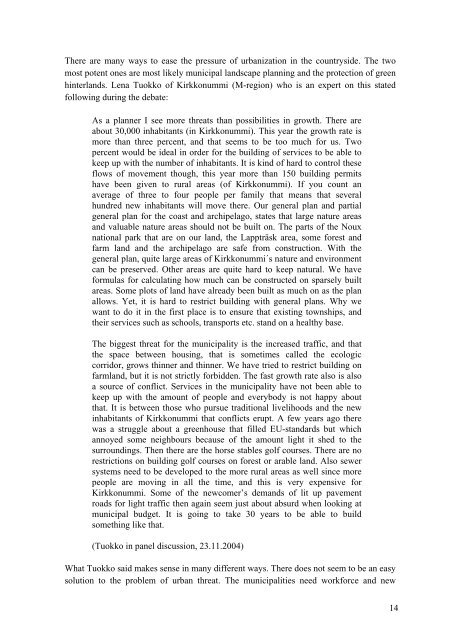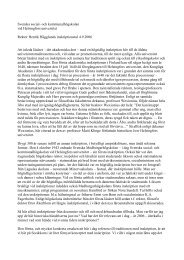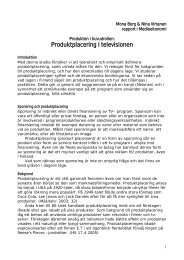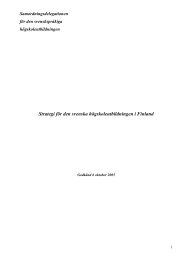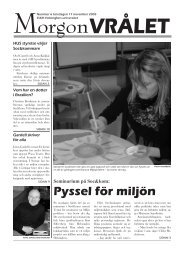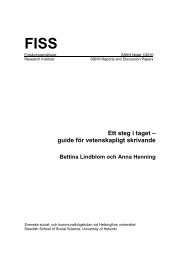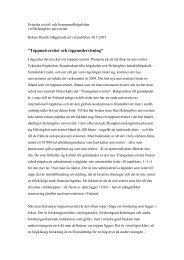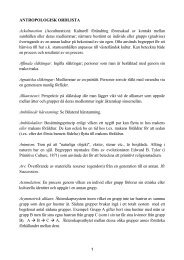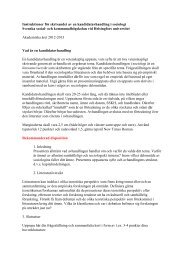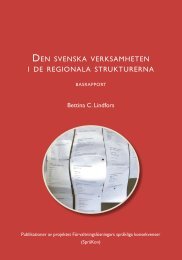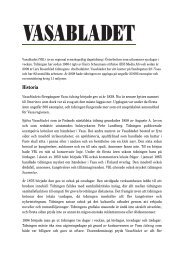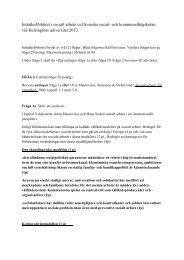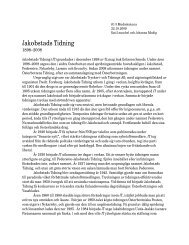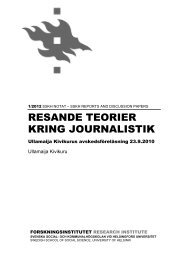FISS - Svenska social - Helsinki.fi
FISS - Svenska social - Helsinki.fi
FISS - Svenska social - Helsinki.fi
Create successful ePaper yourself
Turn your PDF publications into a flip-book with our unique Google optimized e-Paper software.
There are many ways to ease the pressure of urbanization in the countryside. The two<br />
most potent ones are most likely municipal landscape planning and the protection of green<br />
hinterlands. Lena Tuokko of Kirkkonummi (M-region) who is an expert on this stated<br />
following during the debate:<br />
As a planner I see more threats than possibilities in growth. There are<br />
about 30,000 inhabitants (in Kirkkonummi). This year the growth rate is<br />
more than three percent, and that seems to be too much for us. Two<br />
percent would be ideal in order for the building of services to be able to<br />
keep up with the number of inhabitants. It is kind of hard to control these<br />
flows of movement though, this year more than 150 building permits<br />
have been given to rural areas (of Kirkkonummi). If you count an<br />
average of three to four people per family that means that several<br />
hundred new inhabitants will move there. Our general plan and partial<br />
general plan for the coast and archipelago, states that large nature areas<br />
and valuable nature areas should not be built on. The parts of the Noux<br />
national park that are on our land, the Lappträsk area, some forest and<br />
farm land and the archipelago are safe from construction. With the<br />
general plan, quite large areas of Kirkkonummi´s nature and environment<br />
can be preserved. Other areas are quite hard to keep natural. We have<br />
formulas for calculating how much can be constructed on sparsely built<br />
areas. Some plots of land have already been built as much on as the plan<br />
allows. Yet, it is hard to restrict building with general plans. Why we<br />
want to do it in the <strong>fi</strong>rst place is to ensure that existing townships, and<br />
their services such as schools, transports etc. stand on a healthy base.<br />
The biggest threat for the municipality is the increased traf<strong>fi</strong>c, and that<br />
the space between housing, that is sometimes called the ecologic<br />
corridor, grows thinner and thinner. We have tried to restrict building on<br />
farmland, but it is not strictly forbidden. The fast growth rate also is also<br />
a source of conflict. Services in the municipality have not been able to<br />
keep up with the amount of people and everybody is not happy about<br />
that. It is between those who pursue traditional livelihoods and the new<br />
inhabitants of Kirkkonummi that conflicts erupt. A few years ago there<br />
was a struggle about a greenhouse that <strong>fi</strong>lled EU-standards but which<br />
annoyed some neighbours because of the amount light it shed to the<br />
surroundings. Then there are the horse stables golf courses. There are no<br />
restrictions on building golf courses on forest or arable land. Also sewer<br />
systems need to be developed to the more rural areas as well since more<br />
people are moving in all the time, and this is very expensive for<br />
Kirkkonummi. Some of the newcomer’s demands of lit up pavement<br />
roads for light traf<strong>fi</strong>c then again seem just about absurd when looking at<br />
municipal budget. It is going to take 30 years to be able to build<br />
something like that.<br />
(Tuokko in panel discussion, 23.11.2004)<br />
What Tuokko said makes sense in many different ways. There does not seem to be an easy<br />
solution to the problem of urban threat. The municipalities need workforce and new<br />
14


